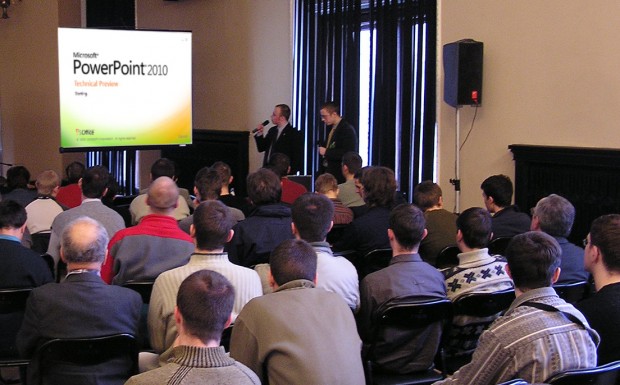According to Kurt DelBene, president of the Microsoft Office Division, as of July 2012 1 billion people worldwide use Microsoft Office (which, of course, includes PowerPoint). With such market penetration, it is no wonder that PowerPoint has become the lingua franca of business communication. But what exactly is a PowerPoint presentation?
A presentation has two basic elements: the presenter and the material. These two elements must work together in concert to create a cohesive whole. It sounds simple, and it is, but it’s surprising how many people lose sight of this concept. To give you an example of how these two elements must coexist for a successful presentation, let’s separate them and see what happens.
In our first scenario, Jayne Smith is the charismatic CEO of WooTech, makers of a wildly popular high-tech gadget. She is giving the keynote at the annual WooTech Conference, which people have been eagerly anticipating. Finally, it’s go time and as Ms. Smith is introduced the crowd erupts into tumultuous applause! Ms. Smith stands behind the podium and smiles as the applause slowly dies down. She gazes serenely at the crowd, head slowly moving back and forth, taking everybody in. Minutes pass, and she says nothing. The rapt silence is broken by confused murmurs as it becomes clear that Ms. Smith will not be saying anything. After a few minutes of this, Ms. Smith thanks the audience and leaves the stage.
In scenario number two, the audience at the WooTech Conference is buzzing. They know there’s an exciting new product launch and they’re looking forward to hearing Ms. Smith announce it during her keynote. “And now, ladies and gentlemen,” the emcee intones, “The moment you’ve all been waiting for: Jayne Smith’s keynote address!” The audience goes wild as the curtain parts, revealing a giant screen. Then the PowerPoint presentation begins, and silently advances through the slides. The text of Ms. Smith’s speech is shown on each slide, along with some charts and graphs. The last slide shows an image of WooTech’s newest product then fades to black. The curtain closes and the lights come up.
Although these examples are extreme, things like this happen all the time. I once attended a lecture by the Andy Warhol that, except for two nonsensical words uttered by the artist, proceeded exactly as in the first example. The audience left the theatre feeling betrayed, the butt of an unfunny joke. It’s more common, though, to see the second scenario played out, as when somebody asks “Could you just send me your presentation?” (By the way, here’s what to do if you’re ever asked this question.)
What good is being a charismatic presenter if you have nothing to say? And why have a presenter at all if the PowerPoint deck includes everything the presenter will talk about? It’s only by combining a presenter with a well-designed PowerPoint deck that isn’t an onscreen manual that you create a successful and influential PowerPoint presentation.

